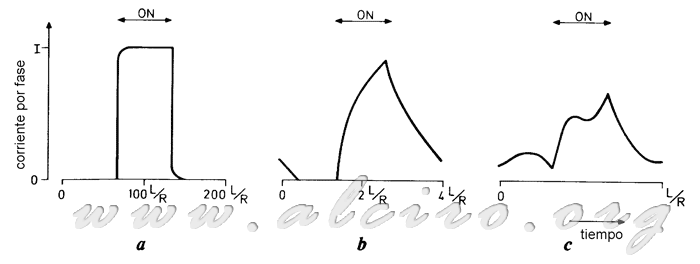2.2.5. High speed operation
In many applications the system must respond quickly, so the engine has to work at high speed, but stepper motors lose torque increases as the ratio of steps.
For example, suppose an engine with a characteristic torque / speed shown in Figure 3.19 you have to move at a distance of 1000 steps. If the load torque is 0.5Nm, the answer is 500 steps per second and the load is positioned in approximately 1000 / 500 = 2 seconds. On the other side for a couple of loads 1Nm top speed is limited to 200 steps per second and the positioning time is now 1000/200 = 5 seconds.

Figure 3.19. Curve maximum operating speed for different load torque.
One reason for high steps phases are excited in a small time interval, and the time of the upslope of the current through the phase represents a significant portion of the range of excitation. When the engine operates at high speed for each phase current never reaches the nominal value as the excitation interval ends and the stage is cleared before the current reaches the maximum value. At this point the current decay phase by continuous flow through the reverse diodes. Consequently the range of excitation is higher than the control dial, stretching beyond the blocking time. As a result the couple for labor falls with increasing frequency.

Figure 3.20. Typical waveform of current through a phase for motor excitation sequence of an active phase. (A) low speed. (B) average speed. (C) high speed.
The calculation of the pair of work (pull out) at high speeds is complicated by variations in the flow during the time of excitation of each phase, these conditions have a direct relationship between the static torque and dynamic torque of the motor. The typical waveform of the current for unipolar excitation of a variable reluctance motor of three phases with a sequence of excitation of an active phase is shown in Figure 3.20. Operating at low speed (Fig. 3.20.a) the current is roughly rectangular, and can obtain a direct relationship between the static and dynamic torque (see section 3.2.2). For step relationships in which the phase is excited with a time similar to the winding time constant, the waveform (Figure 3.20.b) is considerably distorted with a slope of rise and fall exponentially.
Operating at very high frequency of steps, the induced voltage in the windings of each phase by the motion of the rotor is very considerable. The effects of this tension can be seen in the waveforms in Figure 5.2 (c), this waveform can not be defined in terms of a simple exponential. For a full analysis of the dynamic characteristics of torque / speed (pull out) will have to include the effects of induced voltage in the coil by movement of the rotor.







